10 years of Crimean resistance. How modern Ukrainian art tells about Crimea – Publications
[ad_1]
February 26, 2014 thousands of people came under the building of the Verkhovna Rada of Crimea to support the territorial integrity of Ukraine. This date became the Day of Resistance to the Occupation of Crimea.
Now, 10 years from now, February 26 is a reminder of what happened, and an opportunity to get closer to the history of Crimea in various ways, including through art. UP Culture tells about 11 works of modern Ukrainian artists, which interpret the theme of Crimea and its occupation. Among them, in particular, works Pavel Makov, Zhanna Kadyrova and Maria Kulikovska.
Immersive installation “Garden is now a track” commercial public art and Svetlanka Konoplyova
“The garden is now a track”.
Art Arsenal, Facebook
Svetlanka Konoplyova – one of the members of the artistic team commercial public art, but it was her story that formed the basis of the created installation. Svitlanka herself is from Simferopol, and due to the occupation of the city, she has not been able to get there since 2014. Those places that remained in her memory are no longer there. One of them is an apple orchard near the house, which the occupiers destroyed in order to build a wide traffic interchange.
The installation is built from a large screen with an image of a long track. If you look at it for a long time, it seems that it does not end. Broken branches lie on the ground – as a symbol of the apple orchard cut down by the occupiers.
This installation is about how the Russian occupation changes the landscapes we are used to and the purpose of the roads we used to travel on. After all, now Russian tanks travel along these roads.
The series “Crimea and Home” by Renata Asanova
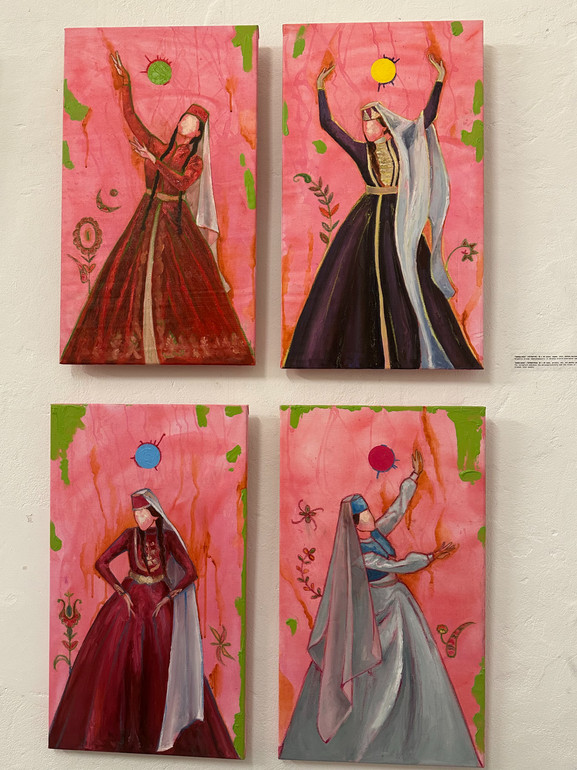
Works by Renata Asanova.
Olga Dudenko
Renata’s father is a Crimean Tatar who was deported from the Motherland. The artist herself had never been to Crimea, and this became one of the incentives to create a series of paintings dedicated to the peninsula: “This project is also my personal journey in search of answers to the question ‘who am I’ and how my roots and identity influence my art and life”.
Such questions are relevant even in times of full-scale war, when native places become unreachable due to occupation.
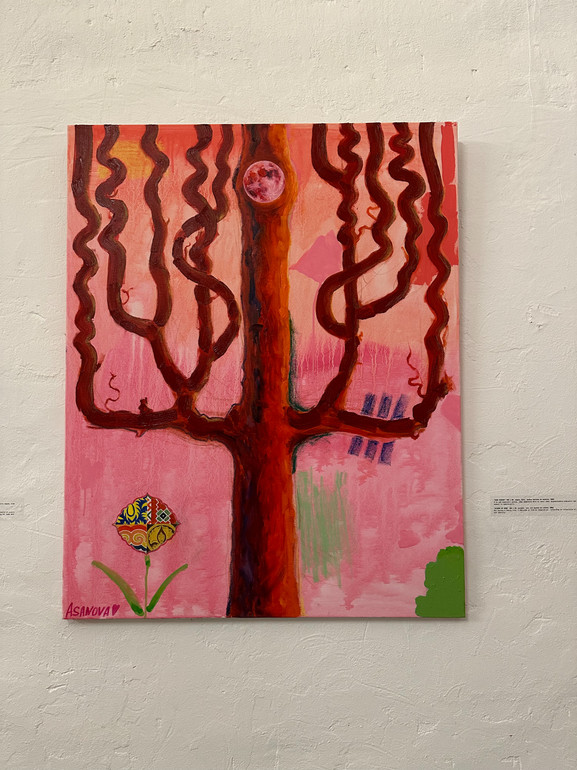
The work “Rivers of Mind” by Renata Asanova from the series “Crimea and Home”
Olga Dudenko
One of the paintings in the series is “Rivers of Mind” – depicts a huge tree with a red trunk and thick branches. The artist explains: “I don’t have a family tree, so I depicted it from my imagination, reflecting reflections about my own roots and identity.”.
Mystkina shows how similar the values of the Ukrainian people and the Crimean Tatars are, and this is what unites us. In addition to self-identity, the series highlights the issue of preserving the cultural heritage that we may lose due to Russian crimes.
Project-installation “Several stories and objects” by Lesia Khomenko

Several stories and objects.
Voloshyn Gallery
Works in the project Lesya Khomenko tell about life in Crimea through people’s stories. Among themselves, they are divided into two camps: in the first – public people who were born in Crimea, but can no longer live there due to the Russian occupation; in the second – Russian cultural figures who cannot enter Ukraine because they visited Crimea after its annexation.
The space of the installation is built in such a way that it is rich in information, and the characters in it confront each other. We see the background and actors, so the work increasingly resembles a theater scene.
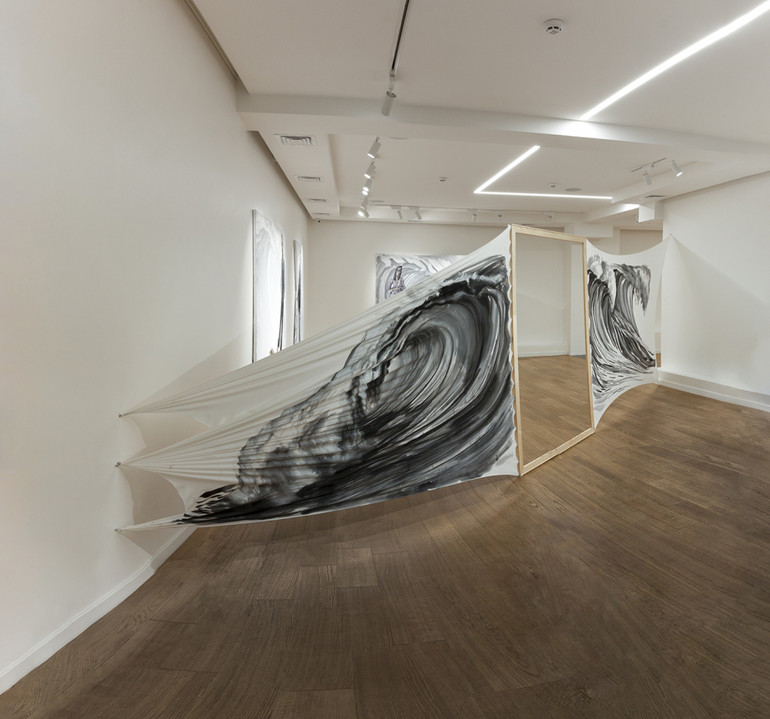
Several stories and objects
Voloshyn Gallery
People in Lesya Khomenko’s installation become objects because they lose their subjectivity, instead fulfilling a certain role in the history of the artist. They argue, they are pressured by informational noise, and therefore, we are not able to recognize what they say is the truth and what is manipulation.
Graphic work “Simferopol Landscape” by Pavel Makov
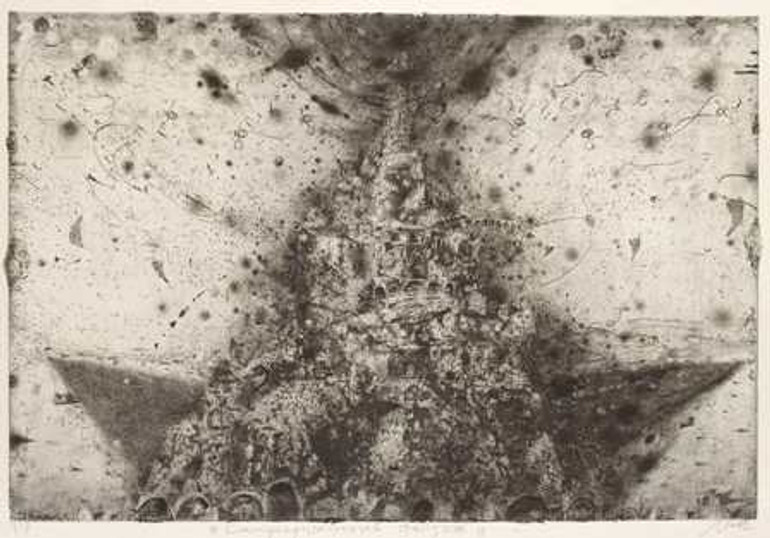
Simferopol landscape
Research Platform Online Archive
Simferopol is a city in which Pavel Makov spent his youth years studying at the Crimean Art School in the 70s. Etching “Simferopol landscape” Makov created at one of the 1988 Sedniv Plein Airs. They were organized by the Union of Artists of the Ukrainian SSR in the town of Sedniv in Chernihiv Oblast.
Compositionally, the work is built on the model of the Tower of Babel: the image resembles chaos and a cluster of details that connect into a triangle in the middle. Among them are building facades, architectural elements, and a bowl. A whirlwind in which everything is lost, as well as the feeling of a city that no longer belongs to you.
Sculpture “Untitled” by Zhanna Kadyrova
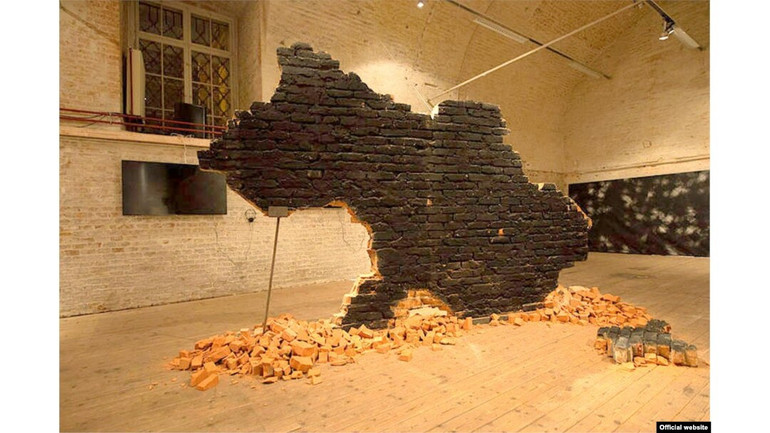
Zhanna Kadyrova’s project
Making sense of the past and historical trauma through art is a characteristic theme for the practice Zhanna Kadyrova. “No title” – one of the attempts to understand what happens to the country in wartime conditions, when it is forced to constantly defend itself.
The sculpture is built in the shape of a map of Ukraine, but its borders are broken and burned. On the floor there are parts broken off from it. Zhanna carved the sculpture itself from the brick wall of an abandoned factory, one side of which is charred, and the other has preserved the remains of Soviet wallpaper. Thus, the work makes it possible to draw causal connections between what is happening now and the regular oppression of Ukrainian independence in the past.
Thus, the work makes it possible to draw causal connections between what is happening now and the regular oppression of Ukrainian independence in the past. Now this work can be seen in the courtyard of the Art Arsenal.
Action “Raft “Crimea” and performative sculptural installation “Stardust” by Maria Kulikovska
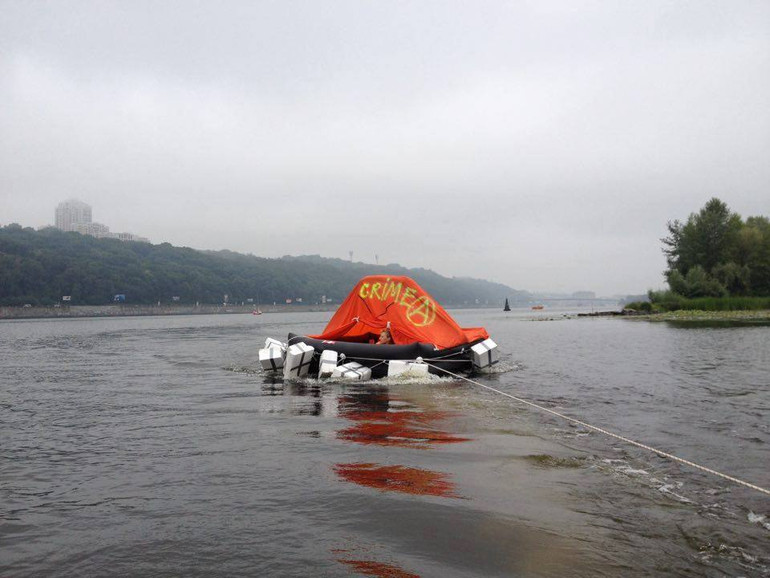
Crimea raft
Maria Kulikovska
Maria Kulikovska – an artist originally from Crimea, who moved to Kyiv in 2014 due to the Russian occupation.
In 2016, the artist organized a campaign “Raft “Crimea”, drifting on a home-made boat along the banks of the Dnieper. Maria planned to spend three days on the raft without food or water, thus showing the conditions in which internally displaced persons find themselves and how much their well-being depends on their environment. A boat, like a person, also migrates, and in it there are no signs of the usual home with our photos, clothes and favorite things.
Raft “Crimea” also became a reminder that everyone can find themselves in a dangerous situation and lose their home. During the action, various people brought food for the artist, but none of the observers sat down with her on the raft.
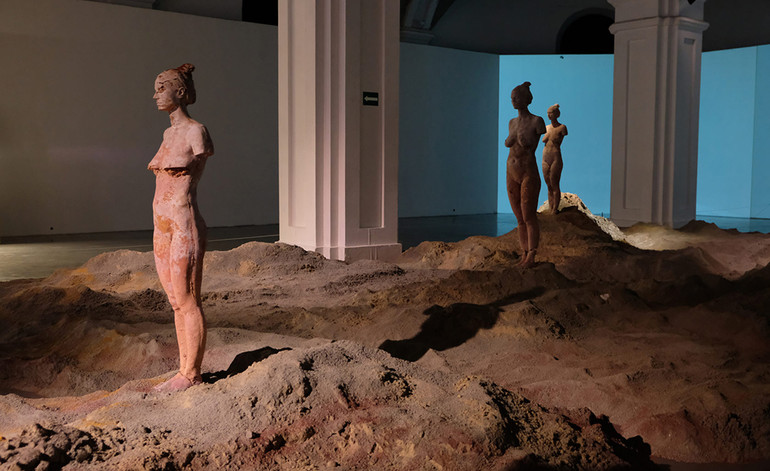
“Stardust”
Maria Kulikovska
The main medium for Maria Kulikovska’s sculptural works is her own body. She also used it for installation “Stardust”. Maria creates her own map of the Kerch Peninsula, filling it with various materials: wood, sand, sea salt, minerals, earth.
On the curves of this map are casts of Kulikovska’s body. The artist seems to be split in the space of her hometown, and there is no material to connect herself.
Qirim series by Sergey Burbela
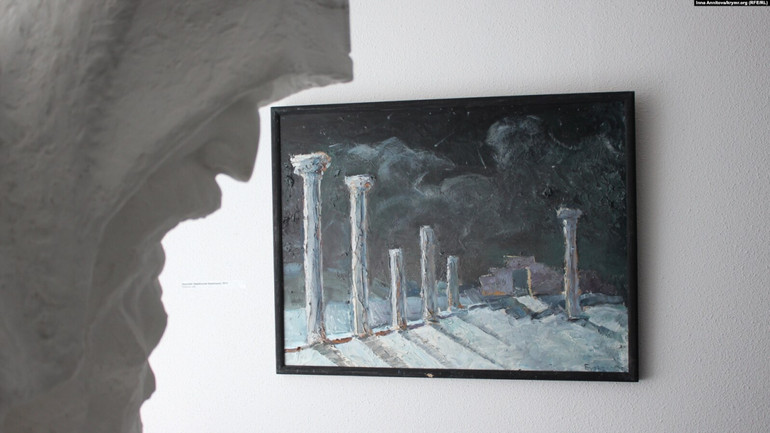
Serhiy Burbelo “Khersones Tavriyskyi”.
Crimea. Realii
Serhiy Burbelo often visited Crimea before its occupation. The image of the peninsula as he remembers it is embodied in a series of landscapes Qirim – “Crimea” Crimean Tatar
Serhiy started working on it in 2013 and says that he does not see the end of the series. New elements are added in each exhibition that exhibits Qirim, and this helps to perceive the peninsula according to its transformations under the influence of occupation.
For example, most of the landscapes were originally conceived by the artist as a depiction of a moonlit night in the Crimea, but now other connotations are imposed on these images, and the romance of the night resembles darkness.
At one of the exhibitions in Kyiv, the series was surrounded by barbed wire. He personified the lack of access to Crimea for both people living in Ukraine and those who remained under occupation.
The play “Out of reach” by Oleksandra Teterina and the play of the same name by the PostPlay theater

Fragment of the performance “Out of Reach”
Oleg Davydenko
In his play Oleksandr Teterin described the history of Crimea in the form of short notes and tense conversations with border guards. From these laconic reflections and dialogues, a feeling of war is revealed, which the author feels. The performance based on her play was staged by PostPlay – a documentary theater whose projects are based on real stories and events.
The main male role in the play was played by a veteran of the ATO and a public activist Serhii Vikarchuk. The director of the play Piotr Armyanovskyi says that you should not expect a happy ending from the play, but there is still hope in the plot.
Installation “Khaitarma. Return” by Rustem Skibin

Haitarma. Return.
Ukrinform
Rustem Skybin – Crimean Tatar ceramist. “Khaitarma. Return” it was the first project of such a large scale for him. The work consisted of objects that directly formed the installation, and a performative part where, together with Kherson artists, Rustem created an ornament that symbolizes the road.
In the installation, you can see fabrics with colorful Crimean Tatar ornaments, the inscriptions “love” and “Crimea” in Crimean Tatar, large flowers that serve as stops in the middle of the path, where you can stop and think. The basis of the work is paving tiles, and there are 9 of them in total. For the Crimean Tatars, the number nine represents the beginning, material and spiritual wealth.
“Khaitarma. Return” interprets historical memory through return, finding a way to one’s territory, culture, language, and family ties.
Audiovisual work “Nobody is an Island” by Oli Mykhailiuk and SK.EIN
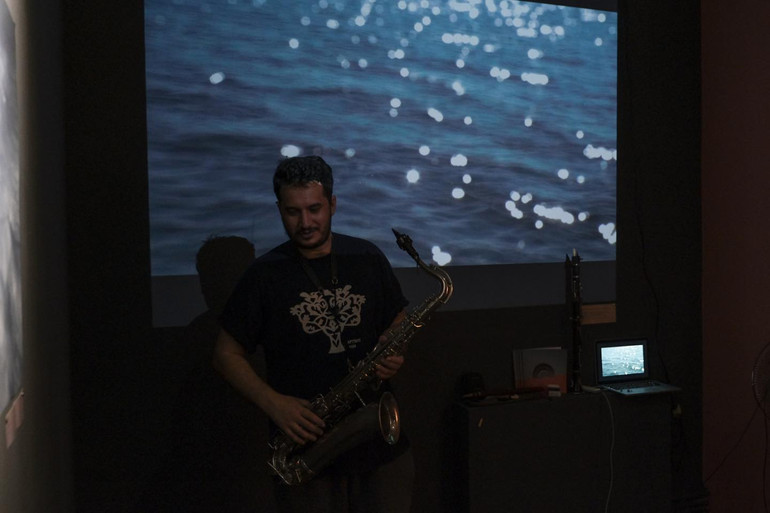
No one is an island
ArtPole agency
Artist Olya Mykhailiuk and sound artist SK.EIN reproduced Crimea on sound. In their audiovisual work, you can hear the sound of waves, grasses, wind, shells in the Crimea, Crimean Tatar music.
“Since we have no way to get to Crimea, we decided to at least get as close as possible to it. Collect sounds, colors, textures on the border in the form of audio and video files, and start working from there“, says Olya.
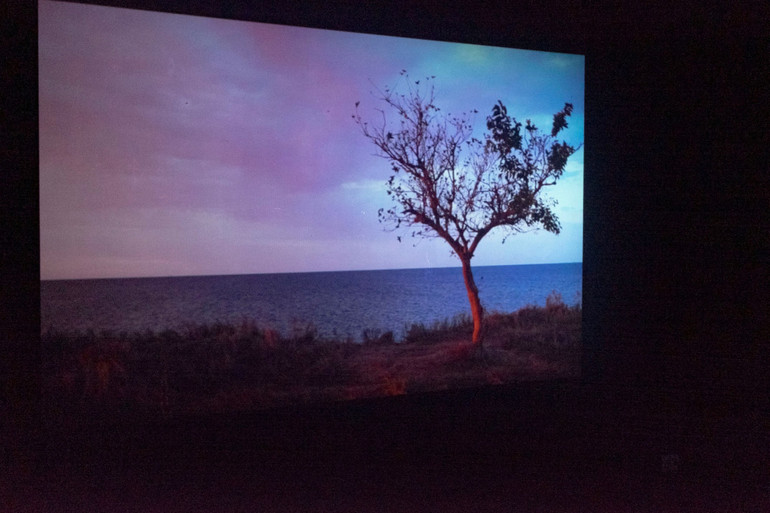
No one is an island.
Facebook page of the project
The main material was recorded on the Khorly Peninsula, 30 km from Crimea. Musicians Mustafa Kyzyldeli, Suren Voskanyan and Andriy Levchenko joined the project with their improvisations.
On the one hand, the audiovisual work has a meditative mood, on the other hand, it creates a disturbing space for understanding one’s own traumas and memories. And it also becomes one of the ways to move to Crimea, when there are no physical roads there.
[ad_2]
Original Source Link











